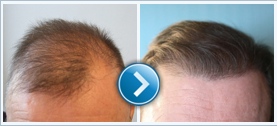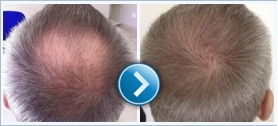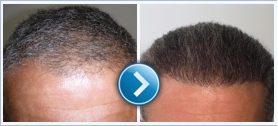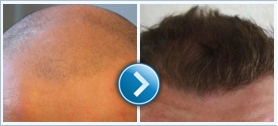About the FUE
About the FUE
The origin of the FUE
The idea of harvesting donor hair in follicular units comes from an Australian surgeon, Dr. Woods., but he didn’t share details of his method with anybody.
Hair transplant FUE method was first published by Dr. Rassman and Dr. Bernstein in 2002 (Follicular Unit Extraction: Minimally Invasive Surgery for Hair Transplantation). This article described the procedure in detail, named it, and also explained the FOX test which serves for determining the characteristics of the donor area of patients.
The FUE hair transplant method spread all over the world following the appearance of the article.
Hair transplants using FUE
 The FUE (Follicular Unit Extraction) method means harvesting the hair’s natural groupings, so-called follicular units, which will then be implanted. The instrument used for FUE makes a small circular section on the scalp around the follicular unit, separating it from the skin tissue. Then the unit is removed using surgical tweezers. Only a minuscule circular mark will remain on the scalp.
The FUE (Follicular Unit Extraction) method means harvesting the hair’s natural groupings, so-called follicular units, which will then be implanted. The instrument used for FUE makes a small circular section on the scalp around the follicular unit, separating it from the skin tissue. Then the unit is removed using surgical tweezers. Only a minuscule circular mark will remain on the scalp.
These steps are repeated until the surgeon has harvested sufficient amounts of follicular units, also called grafts, to create the look agreed upon with the patient. The entire procedure lasts a few hours, but for a large amount of grafts, it can be repeated on the following or even on a third day. The tiny hole left on the donor area (of about 1 mm in size) heals within 7-10 days after the procedure. The remaining small white dots are completely covered by the hair on the sides and the back of the head.
This method of harvesting the donor hair, the removal of follicular units one by one is what differentiates FUE from the FUT (Follicular Unit Transplant) method. For FUT, donor hair is harvested by removing a long, wide strip of the scalp, at once. This strip will then be cut up into small units with the help of a stereo microscope before hair is implanted.
Following the removal of grafts, small sections are made on the recipient area, with a small, sharp instrument, determining the exact place where grafts will be implanted. The follicular units are then placed in these holes, where they will grow new and healthy hairs. The difference between FUE and FUT is the harvesting method of the transplanted grafts, and how natural the result will look. Because of the larger, square-shaped grafts of the FUT method, they cannot be implanted to create a real natural look, and it often looks like doll’s hair (lots of hairs in a small “dot”, with large empty spaces among these dots).
FUE hair transplants – who is an ideal candidate?
FUE hair transplant is also the ideal solution for patients who would like to have very short hair following the procedure, because FUE will not leave a large linear scar which could be visible even from a distance. Further advantage of the FUE method is that active athletes can also have hair transplants, as they can continue physical activities shortly after the procedure.
FUE is an ideal solution to correct the unsightly results of earlier strip-harvesting (FUT) procedures. With FUE it is also possible to use hairs from other parts of the body (e.g. beard), which ensures sufficient amount of grafts for those who don’t have enough donor hair on the head.
Many choose FUE simply because it is less invasive than FUT, and it doesn’t feel like a “real” surgical procedure. The truth is, they are both surgical procedures, and the depth of the incision is the same in both techniques. The difference comes from the incision technique and the looks achieved through hair transplantation.
The amount of transplanted hairs
Determining the necessary amount of hairs is difficult. The best estimation is achieved through measuring the surface of the recipient area and the hair volume per square centimeter in that area (an experienced doctor can evaluate it, or a densitometer can be used). Hair naturally has a volume of 130-170 hairs/cm2 on the top of the head and 150-190 hairs/cm2 in the donor area. The volume of transplanted hairs is usually 80-120 hairs/cm2, in some cases (good quality and amount of donor hair) a larger volume can be achieved.
100 hairs/cm2 is generally the minimum amount that can ensure visibly sufficient coverage of a completely bald area (of course, much better looking results can be achieved with a somewhat bigger density, for example 120 hairs/cm2).
It is difficult to determine the size of the recipient area, because of its uneven edges. If we want to lower the hairline on the sides above the forehead by 1 cm, it means an area of approximately 6 cm2 on each side must be considered, that is 12 cm2 altogether. So if we would like to achieve a density of 100 hairs/cm2, 1,200 hairs will need to be transplanted.
After the procedure
- Since FUE hair transplant requires a much bigger donor area than strip harvesting (approximately a 5 times larger area for the same amount of hairs), in case of a bigger procedure it is necessary to cut the hair of the entire donor area 1 mm short.
- 100 hairs/cm2 is generally the minimum amount that can ensure visibly sufficient coverage of a completely bald area (of course, much better looking results can be achieved with a somewhat bigger density, for example 120 hairs/cm2).
- It is difficult to determine the size of the recipient area, because of its uneven edges. If we want to lower the hairline on the sides above the forehead by 1 cm, it means an area of approximately 6 cm2 on each side must be considered, that is 12 cm2 altogether. So if we would like to achieve a density of 100 hairs/cm2, 1,200 hairs will need to be transplanted.
After the procedure
Since FUE hair transplant requires a much bigger donor area than strip harvesting (approximately a 5 times larger area for the same amount of hairs), in case of a bigger procedure it is necessary to cut the hair of the entire donor area 1 mm short.
This may be inconvenient for some patients who normally wear long hair. However, the tiny holes heal much faster than the incision made for FUT procedures where a suture is also needed, and so only 7-10 days after the hair transplant there is no more visible sign of any procedures.








